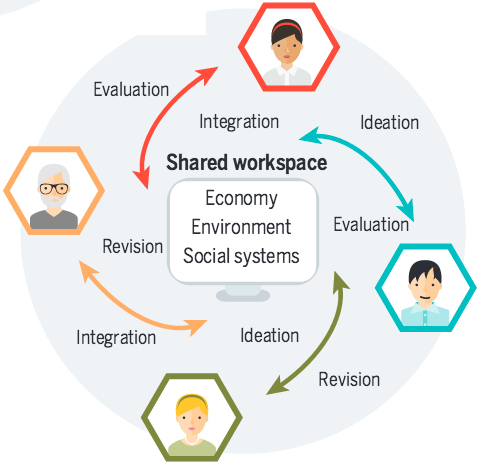Human Computation Institute | Dr. Pietro Michelucci
“Human computation” — combining human and computer intelligence in crowd-powered systems — might be what we need to solve the “wicked” problems of the world, such as climate change and geopolitical conflict, say researchers from the Human Computation Institute (HCI) and Cornell University.
In an article published in the journal Science, the authors present a new vision of human computation that takes on hard problems that until recently have remained out of reach.
Humans surpass machines at many things, ranging from visual pattern recognition to creative abstraction. And with the help of computers, these cognitive abilities can be effectively combined into multidimensional collaborative networks that achieve what traditional problem-solving cannot, the authors say.
Microtasking

Microtasking: Crowdsourcing breaks large tasks down into microtasks, which can be things at which humans excel, like classifying images. The microtasks are delivered to a large crowd via a user-friendly interface, and the data are aggregated for further processing. (credit: Pietro Michelucci and Janis L. Dickinson/Science)
Most of today’s human-computation systems rely on “microtasking” — sending “micro-tasks” to many individuals and then stitching together the results. For example, 165,000 volunteers in EyeWire have analyzed thousands of images online to help build the world’s most complete map of human retinal neurons.
Another example is reCAPTCHA, a Web widget used by 100 million people a day when they transcribe distorted text into a box to prove they are human.
“Microtasking is well suited to problems that can be addressed by repeatedly applying the same simple process to each part of a larger data set, such as stitching together photographs contributed by residents to decide where to drop water during a forest fire,” the authors note.
But this microtasking approach alone cannot address the tough challenges we face today, say the authors. “A radically new approach is needed to solve ‘wicked problems’ — those that involve many interacting systems that are constantly changing, and whose solutions have unforeseen consequences, such as climate change, disease, and geopolitical conflict, which are dynamic, involve multiple, interacting systems, and have non-obvious secondary effects, such as political exploitation of a pandemic crisis.”
New human-computation technologies

New human-computation technologies: In creating problem-solving ecosystems, researchers are beginning to explore how to combine the cognitive processing of many human contributors with machine-based computing to build faithful models of the complex, interdependent systems that underlie the world’s most challenging problems. (credit: Pietro Michelucci and Janis L. Dickinson/Science)
The authors say new human computation technologies can help build flexible collaborative environments. Recent techniques provide real-time access to crowd-based inputs, where individual contributions can be processed by a computer and sent to the next person for improvement or analysis of a different kind.
This idea is already taking shape in several human-computation projects:
- YardMap.org, launched by the Cornell in 2012, maps global conservation efforts. It allows participants to interact and build on each other’s work — something that crowdsourcing alone cannot achieve.
- WeCureAlz.com accelerates Cornell-based Alzheimer’s disease research by combining two successful microtasking systems into an interactive analytic pipeline that builds blood-flow models of mouse brains. The stardust@home system, which was used to search for comet dust in one million images of aerogel, is being adapted to identify stalled blood vessels, which will then be pinpointed in the brain by a modified version of the EyeWire system.
“By enabling members of the general public to play some simple online game, we expect to reduce the time to treatment discovery from decades to just a few years,” says HCI director and lead author, Pietro Michelucci, PhD. “This gives an opportunity for anyone, including the tech-savvy generation of caregivers and early stage AD patients, to take the matter into their own hands.”
Abstract of The power of crowds
Human computation, a term introduced by Luis von Ahn, refers to distributed systems that combine the strengths of humans and computers to accomplish tasks that neither can do alone. The seminal example is reCAPTCHA, a Web widget used by 100 million people a day when they transcribe distorted text into a box to prove they are human. This free cognitive labor provides users with access to Web content and keeps websites safe from spam attacks, while feeding into a massive, crowd-powered transcription engine that has digitized 13 million articles from The New York Times archives. But perhaps the best known example of human computation is Wikipedia. Despite initial concerns about accuracy, it has become the key resource for all kinds of basic information. Information science has begun to build on these early successes, demonstrating the potential to evolve human computation systems that can model and address wicked problems (those that defy traditional problem-solving methods) at the intersection of economic, environmental, and sociopolitical systems.
